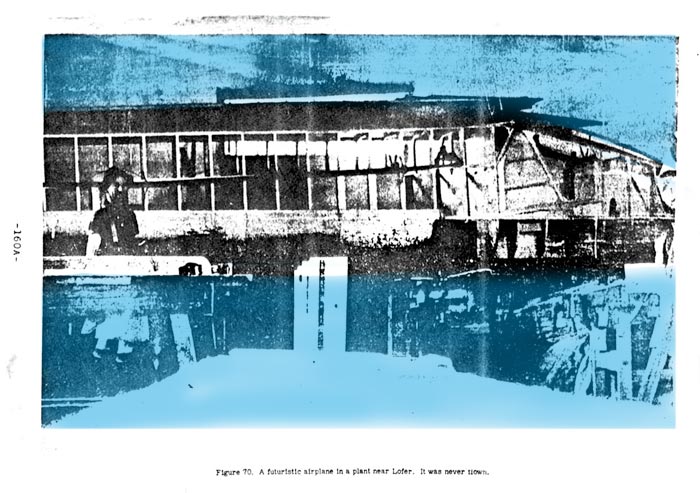Mystery 1945 German Hypersonic Bomber Prototype?
In the late 1930s, Eugen Sanger, one of Germany's top theoreticians on hypersonic dynamics and ramjets, and his wife, mathematician Irene Bredt, had begun developing a suborbital rocket bomber, "RaBo," (sometimes called the "Antipodal Bomber") that would be capable of attacking targets at intercontinental ranges. Incorporating highly advanced concepts, including swept, wedge-shaped supersonic airfoils, a flat, heat-dissipating fuselage undersurface that anticipated the Space Shuttle's by thirty years, and rocket engines of extraordinary thrust, the RaBo concept would have taken many years to develop -- precious time that was running out for Nazi Germany. In 1944, Sanger and Bredt were moved to a fantastic, isolated laboratory complex in the mountains near Lofer, Austria, where a number of bizarre research projects were underway, including impractical devices such as the infamous "sound cannon" and "wind cannon" and an electromagnetic railgun. Sanger's main known project centered on development of a high-speed, ramjet powered manned bomber interceptor that resembled a stubby missile.
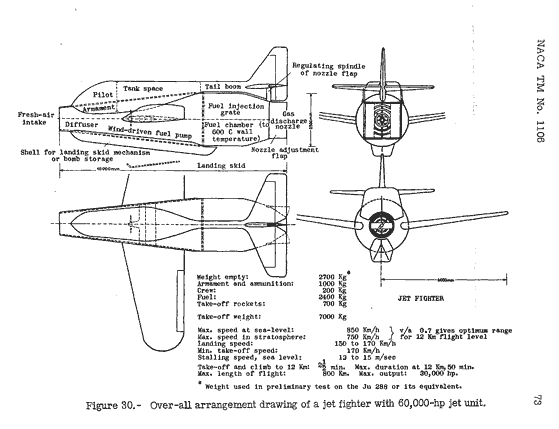 |
Sanger ramjet fighter concept from 1943 DFS report "Uber ein Loreneintreib fur Strahjager," reproduced in 1947 NACA report TM 1106 |
Some sources also indicate that work on the RaBo, which had been suspended around 1942, was revived, and plans for a dedicated "Amerika Bomber" version, specifically intended to drop a 10,000 kg projectile on New York City, were put forward. Sanger produced calculations concerning the enormous energy liberated when the ten ton projectile impacted in lower Manhattan at meteoric speeds. This project paralleled in some respects the equally impressive Peenemunde concept for a two-stage version of the V-2, the A-9/10, that was also intended to strike New York and other northeast US cities.
| See: A-9 |
Most sources indicate that nothing much came of the Amerika Bomber project at Lofer, but this is clearly not the case. The Soviets recovered copies of Sanger's RaBo reports and were so fascinated with the concept (particularly Stalin, who seems to have been riveted by its implications) that they dedicated a great deal of effort to designing an updated RaBo equipped with huge ramjet engines for boost and cruise propulsion. Stalin's son Vasili and rocket expert Grigoriy Tokaty-Tokayev were detailed to follow Sanger to Paris, where he had moved after the war, in a failed attempt to recruit or kidnap him in 1947. The RaBo influenced Soviet manned and unmanned rocket work for years after the war.
|
See: Early Russian Ballistic Missiles (external site) |
It influenced US work too, leading directly to the Walter Dornberger-sponsored Bell "BoMi" (Bomber Missile) project of the early 1950s, and ultimately the USAF/Boeing X-20 Dyna Soar hypersonic glider program that laid the technical groundwork for the Space Shuttle.
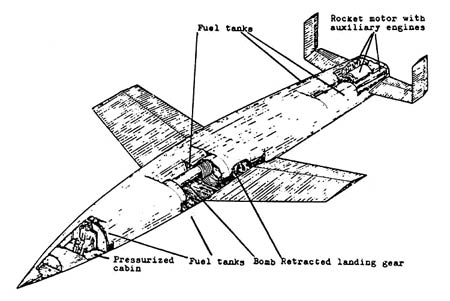 |
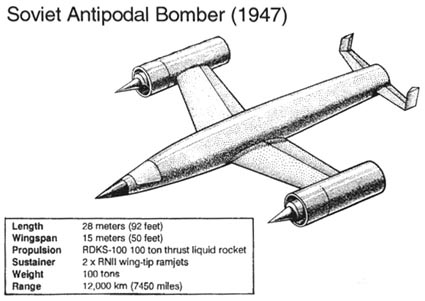 |
|
The Sanger-Bredt RaBo of 1945 (left) compared with its postwar Soviet derivative. Both designs used a long rocket sled to propel the vehicle to its takeoff speed of several hundred mph. After launch, an onboard engine of some 200,000 lbs thrust would propel the craft into a ballistic trajectory that peaked at altitudes of several hundred miles. The German version was intended to be able to reach friendly territory after making its strike -- or possibly ditch near a U-boat -- but the Soviet version had ramjets to provide ascent boost and possibly return-to-base cruise capability after velocity decayed into the supersonic range. (Soviet Antipodal Bomber image from Asif Siddiqi's Challenge to Apollo: The Soviet Union and the Space Race, 1945-1974. Copyright Steven Zaloga) |
|
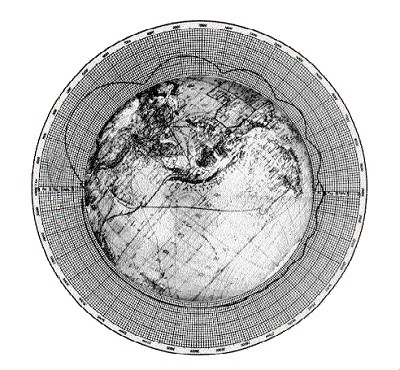 |
Diagram of RaBo trajectory (left). After arcing to altitudes of several hundred miles at speeds of over 10,000 mph, the spacecraft would descend and encounter the upper atmosphere. The pilot would execute a high-g pullout as the craft "skipped off the atmosphere like a stone skipping on water." This cycle would be repeated several times as the vehicle slowed and descended on its global path. When it neared its target, the spacecraft would release a large conventional-explosive bomb that would enter the atmosphere at meteor speeds and strike with tremendous force. It is conceivable that USAAF technical intelligence knowledge of this unique and strange concept resonated with Kenneth Arnold's June 1947 story of supersonic UFOs "skipping like saucers on water" and provided some Air Materiel Command UFO analysts with leverage for study of the saucer phenomenon on the basis of possible Soviet origin. (Click diagram to enlarge) |
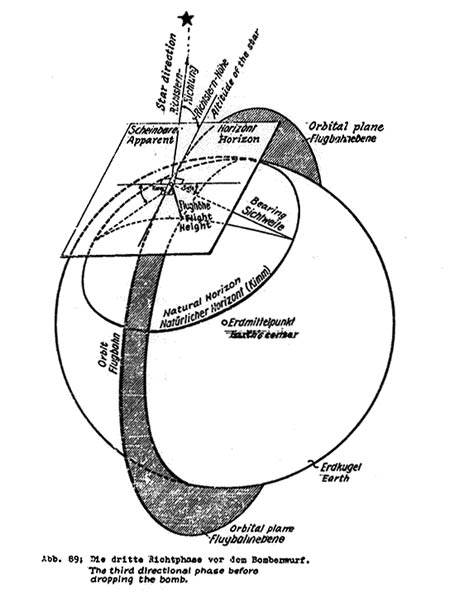 |
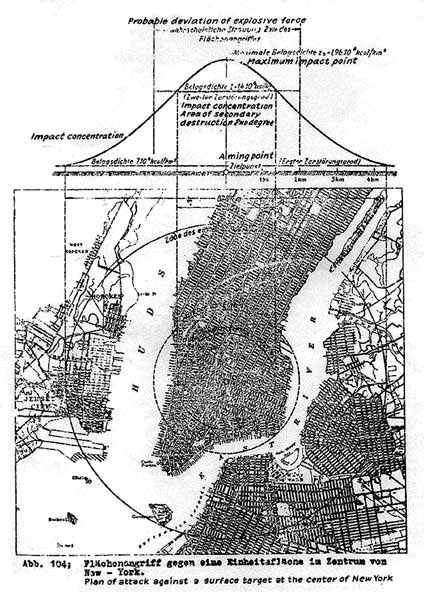 |
|
WWII German diagram (left) shows RaBo inertial reference planes and trajectory measurement axes. Pilot was to navigate by taking star bearings during exoatmospheric ballistic peaks. Diagram (right) shows nuclear-bomb-like energy dissipation and radius of destruction produced by hypersonic impact of RaBo's ten metric ton conventional weapon on its primary target -- lower Manhattan. USAF |
|
No reference source on the Sanger-Bredt project known to the author indicates that any RaBo hardware was built at Lofer. But a 1947 US technical intelligence manual on the Lofer base contains this fascinating, maddeningly blurry photograph (below) of what appears to be the incomplete nose and forward fuselage of a very unconventional aircraft. The caption reads simply, "A futuristic airplane in a plant near Lofer. It was never flown." There are no references to this aircraft in the text of the report.
The fuselage appears to have a flat upper and lower surface, and there appears to be a cockpit area at the right end of the structure. The general shape and size agree with extant RaBo illustrations. Was this a full-scale wooden mockup of the hypersonic bomber? If so, there is little wonder that the Soviets were so impressed with the design. But it raises questions about the lack of documentation on this important prototype.
What was this "futuristic airplane?" Who designed it? What was its intended mission? Why has it been lost? Was it a forgotten part of the Sanger-Bredt program, an ancestor of the US Space Shuttle and Soviet Buran orbiters? If it was not related to the RaBo, what was it?
